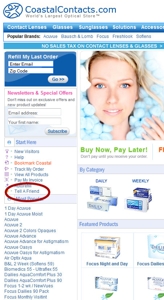For executives like Braden Hoeppner, director of web sales for optical store Coastalcontacts.com, today’s web widgets are a fast and easy way to improve customer service and create interest.
Thanks to the widget behind Coastalcontacts.com’s “Tell a friend” link, “we got more features than we would have initially introduced ourselves,” Hoeppner said, “and we were able to do it a lot more quickly.”
Instead of going to an email page, Coastal Contact’s link opens a pop-up box called Social Notes, created by a San Francisco-based marketing-communications company, PopularMedia, Inc. The free Social Notes widget lets users email the page to a friend; post the page to their Facebook, MySpace or Bebo user profile; post it to one of several popular blogging platforms; or embed their notes and page details on any html-based publishing platform. Senders and recipients can then leave virtual and shareable notes on each page they visit using the Social Notes widget, calling attention to everything from the products they like to deals that catch their eye.
“The results for us are quite positive,” Hoeppner said, shying away from giving actual sales conversion numbers. “Suffice it to say those referrals carry a lot of weight.” Plus, he adds, “a lot of widgets have reporting technology built in—that’s a greater feature set for us. It tracks what pages have the most interest, and what offers encourage word-of-mouth. In the end, it also saved us at least two weeks of internal development effort.”
These are benefits any ecommerce venture can use.
Widgets Offer Functionality
Web widgets are all about providing the functionality that allows interactions shoppers want or need—with low or no development costs. They’re embeddable snippets of code that can feature anything from real-time stock results to local weather, provided free from open-source computer programmers or companies who generate revenue from integrated ad links. These can be fill-in forms with results provided at the widget creator’s website (examples include dating matches or trip searches), or data feeds imported directly to the widget publisher’s page from shopping portals or news publishers. What’s next for these online widgets?
“The biggest thing that we’ve witnessed is widgets going from fun and diversionary exercises to mission-critical business applications,” said Jim Calhoun, CEO of PopularMedia, creator of Social Notes. “Configuration problems have been solved over the years, and now the infrastructure is there for business applications that make money.”
How widgets work
Ecommerce sites are using widgets to offer everything from RSS feeds of their catalog’s hottest products to complimentary products—like books or magazines—fulfilled by the widget’s creator. Web widgets range from copy-and-paste “flat” html code to customizable Java script or Flash programming.
“With a little bit of Java script,” Calhoun said, “in 20 minutes you can get your ecommerce site up to speed and save yourself a lot of hassle.”
The challenge, though, is determining what kind of widgets will enhance the website experience. Is the widget simple for your visitors to figure out on the fly? Does it complement the site’s business mission? Will it increase traffic, or divert it to the widget creator’s website instead? If it diverts traffic, can this be mitigated by revenue sharing or co-branding with the widget’s creator?
“The success of a widget is less about the fact that it’s a widget and more about the purpose it’s serving. We think shoppers want to share in our value proposition. With Social Notes, we got everything we wanted and more,” Hoeppner said.
Example Widget
Some Widget Resources
- Yahoo! Widgets for Windows or Mac OS
- Widgetbox Widgets
- Open-Source Widgets from YourMinis.com
- News Widgets from Digg
- TMZ Fix
- Calendar Widgets from YourMinis
- Yahoo! Day Planner Widget
- Travel Widgets from Kayak
- Bookmark Widgets
- “Site Popularity” Widget for touting Google Page rank, Alexa Rank, Yahoo back links and Technorati links, from Popuri
- Book, CD, DVD, video game and video game hardware/accessory Shopping Widgets form MeCommerce or Amazon.com
- Currency Conversion Wizard





